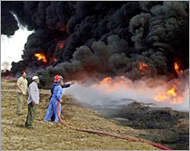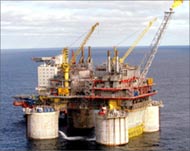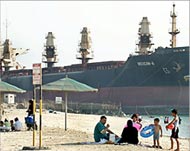Oil barons set to reap winter windfall
Against the forecasts of many analysts,oil prices are once again touching $50a barrel. The main reason given forthis current rise is a cold snap in theUnited States.

But as we have seen before, that mass media version of reality may be not so real after all.
There is no doubt that the weather in the US has some effect on oil prices. So far the American winter has been generally mild, but recently forecasts and temperatures have begun to worry traders.
As cold weather has arrived in North Eastern USA, this has driven up the consumption of heating fuels, also known as heating distillates.
This in turn depletes the reserves of heating distillates held at US oil refineries. These reserves are of course the quickest, fastest way to supply fuel to the US domestic market.
When those reserves are run down (down 7% year on year, currently at five-year lows), they create upward, or “bullish”, pressures on prices.
 |
|
Repeated pipeline attacks in Iraq |
The Iraq factor
As a result, the cold snap and the forecasts for its continuation have created increased demand.
Another reason currently given is the level of attacks on oil facilities in Iraq. This year alone there have been at least eleven major attacks reported in the first 14 days.
All these attacks have been on oil pipelines and have resulted in the deaths of three private military contractors.
The attacks have largely been in the north of the country around the Fatah pipeline complex close to Baiji. Other facilities south of Baghdad or further north near Kirkuk have also been attacked.
Combined with cold weather and Iraqi pipeline attacks, some announcements from OPEC have also troubled market makers. The decision in December by OPEC to cut production by one million barrels per day (mbpd) have been met with a variety of reactions.
Supply outages
With a new OPEC meeting on the same day as Iraqi elections, 30 January, the market is awaiting confirmation of production cuts with some trepidation.
Added to this has been reports of unrest in Nigeria and storms in the North Sea forcing supply outages.
 |
|
Storms in the North are thought |
Hence one can see how the market generally accepts that supplies are once again too tight for comfort, pushing prices higher once again.
However, all these generally accepted reasons for oil price rises hide some uncomfortable truths for the oil market.
First, the lack of refining capacity in the US is not a matter of luck. It has been a matter of choice for US refiners for some time.
“If the US petroleum industry doesn’t reduce its refining capacity, it will never see any substantial increase in refinery margins,” an internal Chevron document in November 1995 reported by the Associated Press said.
Reluctant to store
In 1996 a leaked memo from Texaco marked “highly confidential” said excess capacity was “the most critical factor” facing the US refining industry. This excess capacity was producing “very poor refining financial results”.
Dick Cheney himself has called for an increase in US refining capacity to force down prices. Yet in the last quarter century, no major refineries have been built in the US and many tens of smaller ones have been forced to close.
|
“Cold weather is just one factor, but they all add up. But the lack of refining capacity is a long-term problem” Bruce Evers, |
Not only have US refiners chosen to cut capacity to increase their profits, but as oil prices rose in 2002 to the present day refiners have become even more reluctant to store excess capacity at such a high price.
“It doesn’t take much to disrupt the supply chain,” Bruce Evers of Investec Bank in London told Aljazeera.net.
“Cold weather is just one factor, but they all add up. But the lack of refining capacity is a long-term problem.”
As Deborah White, senior energy economist at Societe Generale in Paris put it, refiners want “enough to fulfil their just-in-time operations”. And no more.
Holding expensive oil in storage makes no economic sense for refiners. As a result Americans and the world pay higher prices for their fuels while refiners make more money.
No big change
Iraqi pipeline attacks are also something the market only chooses to become obsessed with, as Aljazeera.net has previously reported.
In the aftermath of the US election, repeated attacks on facilities and oil executives around the US election did nothing to halt a drop of prices from highs of $55 back down to $40.
 |
|
High oil prices are adding to Bush |
“That is right,” Frederic Lasserre, also of Societe Generale at the time, said. “The attention of the market is stocks, refineries and the winter temperature. The situation in Iraq is not a big change.”
Evers looks at the pipeline attacks as more of a “psychological problem” for the markets.
He said, “The pipeline in the north (of Iraq) has been out of action repeatedly and the main one in the south is running on reduced supply until the summer, due to technical reasons which they won’t elaborate on, but which could be power shortages.”
OPEC announcements are also far less important than they used to be. OPEC has long since lost the ability to control the upside of prices.
The 11-strong producers’ club has itself admitted that its quota-based output limits are routinely flouted by its own members.
Production reality
Production “cuts” announced by OPEC in December are seen by many as merely being methods of sustaining higher prices.
“They (OPEC) are muttering about this production cut,” Evers said. “If prices begin to sell off, then you could see cuts starting from around 1st March.”
|
“The attention of the market is stocks, refineries and the winter temperature. The situation in Iraq is not Frederic Lasserre, |
But the temptation to pump extra barrels when prices are high is seemingly too tempting for OPEC members to resist. As a result OPEC’s meeting in Vienna on 30 January is likely to endorse the “cut” of one million barrels per day (bpd) while the reality at production facilities, ports and refineries is likely to remain unchanged.
As well as these somewhat hollow reasons the outages in Norway’s 140,000bpd Daugen field have been restored. The production disruptions of Shell’s controversial Nigerian fields, Belema, Santa Barbara, Ekulama I and Ekulama II, have also all ended.
Price bonanza
 |
|
Supply lines are stretched while |
So while reporters repeat statements from producers, refiners, OPEC, oil multinationals and their PR people, the underlying market fundamentals remain unchanged.
Supply lines are stretched. Demand increases. Field depletion and an inability of producer nations to maintain maximum production for sustained periods are causing price spikes.
“The new (IEA) data was certainly a tick in the box for upside demand projections, but this rise is price is certainly a very interesting one,” Evers says.
Combine this with the desire of producer nations, refiners, oil princes and corporate giants to cash in on this “interesting” price bonanza and one starts to find the real reasons for $40 to $50 oil.
For that select group of people, this winter looks set not to be a cold one but an intensely profitable one. For ordinary Americans the reverse could well be true.